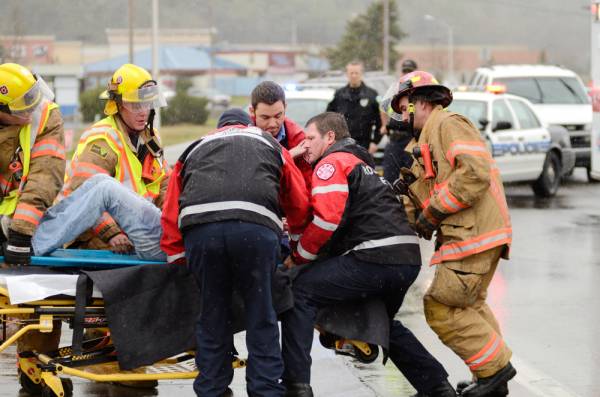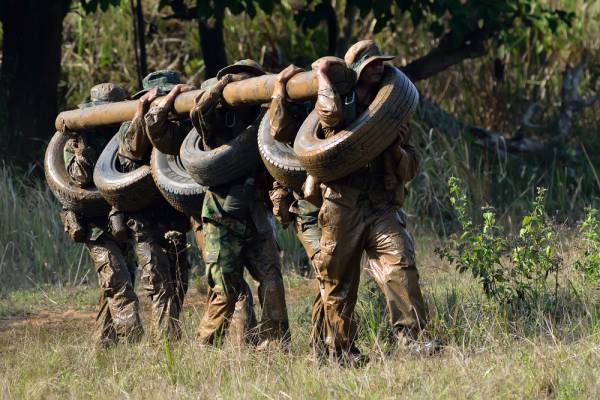Tactical populations are not being adequately prepared or maintained in the strength and conditioning required for their jobs. Too often, firefighters, police officers, EMTs, military personnel, and others dedicated to their tactical careers are led astray in their training. They are given general programs that lack specific, transferrable value in the exercises and progressions.
RELATED: From Cream of the Crop to Fat Cop: You Are Just Being Lazy
This bothers me greatly, as these men and women are putting themselves at risk every day for their country and communities. The smallest drop in tactical strength and conditioning could spell disaster for them and others. We need to address wellness and fitness as a comprehensive, progressive, and ongoing part of any tactical department’s programs.
Within this article, I will provide three simple steps for any tactical individual to construct a field-specific strength and conditioning program. A program that will provide consistent progress regardless of your tactical job demands.
Step One: Assess Your Current Training Program
Many firefighters like to use circuit training, which is an old standby for them. However, studies have shown this form of training to be an ineffective standalone. This approach often needs higher-intensity cardiovascular and resistance training in conjunction with the lower intensity circuit program.
“To reshape the format of a tactical athlete’s programming, we need to look at the specific adaptations and components needed for the work.”
That doesn’t mean circuit training is ineffective in maintaining performance, it simply means it’s far from optimal. For tactical personnel, there should be a focus on progressive programs that address muscular power, agility, speed, and metabolic conditioning in both the aerobic and anaerobic energy systems.
To reshape the format of a tactical athlete’s programming, we need to look at the specific adaptations and components needed for the work. Whenever I speak with an individual or department, I ask certain questions to get a feel for the needs of the job. I then coordinate those needs with training adaptations proven necessary for success in these highly demanding lines of work.
RELATED: The Best Exercises for Firefighters
Here are some questions to ask to see if your tactical training is on the right track:
- Does my training account for environmental changes or factors related to my job?
- Does my training consider the specificity of the operational tasks I am required to perform?
- Does my job require me to be “always ready” or am I preparing for a specific event? (i.e. military deployment)
- Does my training program account for job-specific injury risks, muscular strength, and power needed?
- Am I training how I work?
- These are a small sampling of what you should not only be asking yourself, but anyone you or your department brings in to help reduce the injury or training problems related to your profession.

Step Two: Assess Yourself and Your Work
To get you off on the right foot, let’s break down the first three steps you should take in preparing to change your tactical programming for the better:
- Needs Analysis – What is required for my line of work? What injuries occur frequently? Am I spending a lot of time walking, running, sprinting?
- Personal Analysis – What areas of operational readiness am I strong in? In what areas do I need improvement? How can I maintain the areas where I am strong in while simultaneously addressing my areas of needed improvement?
- Tactical Environment Analysis – Am I preparing for active duty? Am I getting ready for boot camp, fire academy, police academy, PAT examination, etc.? Do I need to be ready to go at any time day or night?
This analysis can take a while to get through, as there are many important items to consider. But once you have a good solid outline, you can move into post-analysis and begin implementation.
RELATED: The Police Physical Ability Test: Would You Meet the Requirements?
Step Three: Assess Your Training Options
Focus on athletic movements. Things such as agility, power, and speed are crucially important for the tactical field, so focus on being a better athlete. Any tactical athlete who is beginning to design a new program based on the questions answered above should consider the use of the following:
- Plyometric training
- Specific metabolic conditioning
- Strength training designed to improve muscular power and strength without affecting day-to-day performance
Plyometrics are proven to be beneficial in improving the tactical athlete. Plyometric training refers to activities that enable a muscle to reach maximal force in the shortest time possible through utilization of the stretch-shortening cycle. More simply, it’s a quick, powerful movement that uses a pre-stretch or countermovement. Its aim is to improve power or explosive capabilities. Plyometric training needs to be adjusted and based around your current flexibility, strength, and agility.
“Focus on athletic movements. Things such as agility, power, and speed are crucially important for the tactical field, so focus on being a better athlete.”
Metabolic conditioning drills are needed to address both your aerobic and anaerobic energy systems. With any metabolic conditioning for the tactical operator, keep in mind that load-carriage training will be very specific and beneficial for you. Doing load-carriage training every seven to fourteen days has been proven to improve your operational efficiency.

Examples of exercises that work your aerobic job-specific ability could be heavy rucksack carries at a steady pace, jogging or running moderate-to-long distances, or stair training. For the anaerobic system, we also want to be task specific. Exercises such as shuttles, sprints, dummy drags, or loaded prowler work should be the focal points for this portion of the programming.
“Examples of exercises that work your aerobic job-specific ability could be heavy rucksack carries at a steady pace, jogging or running moderate-to-long distances, or stair training.”
Strength training comes down to utilizing the muscles and muscle groups most important in performing your operational tasks. There should be a foundational focus on overall strength across multiple muscle groups. From there, you can progress to the maintenance of your strengths while addressing your necessary areas of improvement. Including core exercises such as squats, lunges, deadlifts, shoulder press, and power cleans can be the foundation of your strength portion of the program. You can include auxiliary or secondary exercises when time allows.
RELATED: Study Tests Unconventional Methods of Military Physical Preparation
Summary
I hope this article has not only provided some new concepts and talking points for you within your base, station, or field, but has also given you a conceptual framework from which to begin structuring an effective tactical strength and conditioning protocol.
I would love to hear about what you or your department is currently doing for your tactical strength and conditioning and how your training has been going. Please post your thoughts or questions to the comments below and I will get back to you.
References:
1. Fahy RF, LeBlanc PR, Molis JL., “Firefighter fatalities in the United States — 2005.” National Fire Protection Association. Fire Analysis and Research Division; 2006. Accessed December 14th, 2014.
2. TSAC Report. Issue 35. National Strength and Conditioning Association. Accessed December 14th, 2014.
3. Abel, MG. et al., “Evaluation of Circuit-Training intensity for firefighters.” J Strength Cond Res. 2011 Oct;25(10):2895-901. doi: 10.1519/JSC.0b013e31820da00c.
4. Panthera Training Blog. “3 Plyometric Exercises Needed for Tactical Personnel.” Panthera Training Systems. Accessed December 14th, 2014.
5. Orr, R., “Load carriage for the tactical operator: Impacts and conditioning – A review. ” Journal of Australian Strength and Conditioning (JASC), 2012. 20(4), 23-28.
Photos courtesy of Shutterstock.






